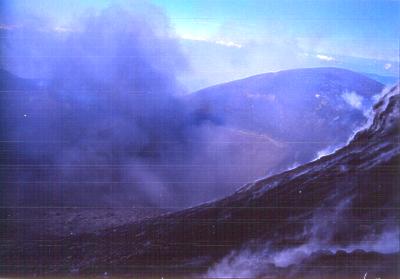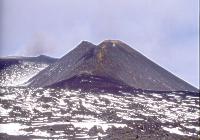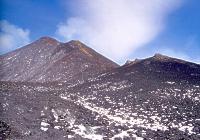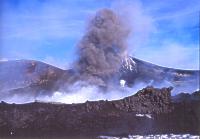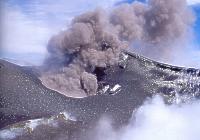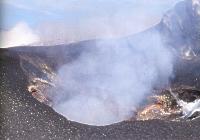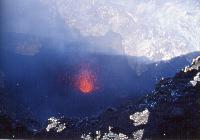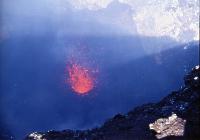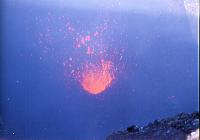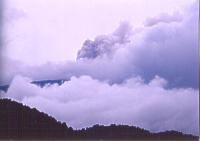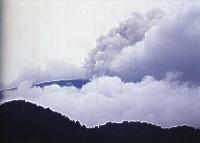|
WARNING:
Access to the summit area is again VERY
DANGEROUS. Explosive activity at the Bocca
Nuova is frequently ejecting bombs far beyond the crater rims,
most notably on its N, NW, W and SW sides. It is still officially
forbidden to go beyond 2700 m elevation on the S flank. Tourists
should make excursions only with the mountain guides, even though
this will not satisfy the wish to see what's going on at close
range. Besides this, weather conditions are often unstable.
Strong wind, snow or rain and clouds are occuring frequently
in the summit area, even during the summer, and one can get
easily lost. The mountain guides can be contacted at the cable
car (near the Rifugio Sapienza) on the southern side of Etna
(phone: 095-914141), or (during the summer) at the hotel "Le
Betulle" at Piano Provenzana, on the northern side (phone:
095-643430).
|
Do you look for books or videos about
volcanoes, volcanology, or in particular Mount Etna? Find and buy
them at Amazon.com!


These
ads help to keep this site alive. Click on them to give a small contribution
without paying anything (but for each click-through purchase made
through the first and last links the contribution will be larger!)
28 October 2000 update.
Spectacular video footage of the ongoing eruptive activity of the
Bocca Nuova has been shown on 28 October in television news in Italy
(RAI) and abroad. Some news agencies picked up the news and transformed
them into reports about lava fountains and strongly increased activity
at "a crater at 3300 m elevation on Etna". The truth is
that the video, which was made by the RAI television cameraman Giovanni
Tomarchio, shows nothing else than what had been observed during Behncke's
recent visits to the active crater. The 1 minute clip, which was presumably
filmed on the evening of 27 October, has mainly views into the active
NW pit (whose floor seems to be much less deep than on 17 October;
see 18 October update below).
The activity at the Bocca Nuova is continuing in a similar manner
as before, with waxing and waning phases. No true lava fountains are
occurring, but the activity consists of discrete, though very frequent,
Strombolian bursts.
26 October 2000 update.
A new visit was made to the summit of Etna on 25 October by Behncke
and two PhD students of the Dipartimento di Scienze Geologiche of
Catania University. This visit revealed ongoing eruptive activity
at both vents within the Bocca Nuova and the formation of a new collapse
pit in the SE part of the crater.
The activity had been quite intense on the evening of 24 October,
when mountain guides from the S side of Etna had visited the summit
area. Powerful explosions prevented them from reaching the rim of
the Bocca Nuova, but they could make observations from the Voragine.
Bombs frequently fell outside the crater. Furthermore the guides observed
incandescence at the spatter cones that had formed in late August
at the lower end of the eruptive fissure on the NNE side of the SE
Crater cone.
On 25 October the activity in the Bocca Nuova was at slightly lower
levels, though significantly stronger than during Behncke's previous
visit on 17 October. Explosions within the NW pit of the crater occurred
every few minutes, but most ejecta fell back into the pit. Larger
explosions occurred every 5-10 minutes. Some produced vertical jets
of bombs, most of which fell back into the pit, but some projected
bombs far beyond the rims of the pit, and bombs rained down over a
radius of up to 300 m from the pit. During 1.5 hours of observation
from the SW rim of the Bocca Nuova it happened twice that bombs fell
as close as 10 m from the observers. It was noted in particular that
during such explosions bombs traveled on many different trajectories,
some quite high (so that the flying bombs were well visible in the
air), but others at very low angles, which made them almost invisible
to the observers. Explosions of this kind are
quite hazardous to visitors to the crater, especially such visitors
who lack any experience, and it should be underlined once more that
the summit craters are off limits and tourists should in no case approach
the rim of the Bocca Nuova.
Due to the risk of stronger explosions it was impossible to obtain
any views of the interior of the pit (whose floor had been about 50
m below the S lip on 17 October), but from the noise and from the
angle of ejections it could be assumed that there has been little
infilling of the pit since 17 October.
Activity at the E vent was less violent, and only at nightfall did
incandescent fountains become well visible. Most explosions produced
plumes of brownish ash mixed with incandescent lava fragments. The
source of this activity was in the S part of the vent, and the magma
level appeared quite deep.
The most significant change since Behncke's 17 October visit was the
formation of a new collapse pit immediately to the S of the E vent.
This new pit was about 80 m in diameter and it was connected to the
E vent, with a low, craggy septum between the two. No eruptive activity
occurred at the new pit, but it constantly emitted a dense plume of
white vapor, hiding its interior from view. The position of the pit
corresponds to the site of the former SE vent of the Bocca Nuova,
which had been buried during the October-November 1999 activity, whereas
there had been no active vent previously in the location of the E
vent.
During the descent towards the Rifugio Sapienza (which is currently
closed to renovation works), which was made at dark, an incandescent
spot was well visible on the upper SE flank of the SE Crater. The
intensity of the incandescence was not constant, but at times was
barely visible while at other times it was distinct.
No observations could be made of the other summit craters during the
25 October visit, but Giuseppe Scarpinati reports that during the
last few nights a faint, fluctuating incandescence has been visible
at the NE Crater. This is not visible with the naked eye but only
with the help of a night amplification viewer. Scarpinati interprets
this incandescence as evidence of deep-seated Strombolian activity
within the central pit of the NE Crater.
24 October 2000 update.
Eruptive activity has continued at the Bocca Nuova through the past
four days. Both vents in that crater were active, with frequent Strombolian
explosions and occasional ash emissions. Sporadic observations made
at night revealed fluctuating glow at the crater at the sites of the
two vents; in a few cases explosions sent incandescent bombs more
than 150 m above the rim of the crater. No direct observations have
been made since 17 October of the interior of the Bocca Nuova, so
that it is not known whethere there has been further infilling of
the NW vent, whose floor was about 50 m below its rim on 17 October.
So far there is no evidence of effusive activity at the Bocca Nuova.
The slow heating of the SE Crater, noted since a few weeks, is continuing,
and now there are several incandescent spots visible in the upper
part of its cone, the most conspicuous on the SE side of the crater
rim.
20 October 2000 update.
The continuing eruptive activity at the Bocca Nuova is going through
highs and lows. On the evening of 19 October, Scarpinati was unable
to see incandescence with his naked eye, and even his night light
amplifying viewer revealed only a very weak incandescence at one of
the active vents of the Bocca Nuova. However, on the early morning
of 20 October (before sunrise), the activity had intensified notably,
and incandescent bursts were perfectly visible with the naked eye.
Using a telescope, Scarpinati was able to see bombs flying high above
the crater.
During the forenoon of the same day, the Bocca Nuova was seen to emit
a dense yellowish-white gas plume occasionally mixed with ash, and
the activity seems to continue vigorously.
|
The
summit craters of Etna,
17 October 2000
Photos
by Boris Behncke
|
|
|
|
|
Left:
The SE Crater cone and the Sudestino (dark mound at base of
the SE Crater cone) seen from Torre del Filosofo on 17 October.
Part of main summit cone is visible in left background
Right: Photo taken from the SW side of the Sudestino (at right)
with the SE Crater cone at left. Gas plume before the blue sky
comes from the Bocca Nuova (out of the photo towards left),
not from the SE Crater
|
|
|
|
|
Eastern
vent of the Bocca Nuova emitting ash, seen from SW rim of the
Bocca Nuova (left photo) and from S rim of the crater (right
photo). Note that the rim of the vent is darkened by countless
fresh bombs in the right photo
|
|
|
|
|
Left:
Eastern vent of the Bocca Nuova during a Strombolian burst without
ash emission (ejected bombs are visible in the large version
of the image)
Right: Wide angle view into the NW pit of the Bocca Nuova, showing
active vent on its floor, about 50 m below the rim. Incandescent
fountain is about 10 m high, but many bombs (invisible in this
image) are rising higher than the rim of the pit
|
|
|
|
|
Zooming
on the active vent on the floor of the NW pit of the Bocca Nuova.
Inactive second vent to the right of the erupting one is not
visible due to gas plume filling the pit
|
18 October 2000 update.
Another visit was made on 17 October to the active Bocca Nuova by
Behncke, who was accompanied this time by two students of the University
of Catania. The observations revealed ongoing eruptive activity at
both vents of the Bocca Nuova and a significant amount of infilling
of the NW vent of that crater.
On the outer SW and W flanks of the main summit cone, several dense
bombs and scoria clasts (0.1 to 1 m in maximum diameter) were found
during the ascent to the Bocca Nuova; these had been ejected during
stronger activity at the NW vent - a circular pit with vertical walls
and a diameter of about 150 m - on the previous days. During the 17
October visit that vent was not as violently active as during Behncke's
most recent visits on 10 and 13 October, but loud degassing occurred
almost continously after the group had reached the SW rim of the Bocca
Nuova. Occasional louder explosions ejected bombs a few tens of meters
above the lip of the pit. Only rarely did bombs fall outside the pit,
and when this happened, they fell mainly to the S and SE of the pit.
At the same time the E vent ("1964 vent") showed a much
more spectacular activity. Since the early forenoon that vent had
produced frequent emissions of brownish-gray ash, and observation
from the SW rim of the Bocca Nuova disclosed that most emissions were
accompanied by strong Strombolian bursts, which ejected bombs up to
150 m above the vent. Many bombs fell outside the vent, mainly to
the S and NW. The crater floor to the S of the two active vents was
covered with thousands of bombs ranging in size from 5 cm to 1.5 m.
The remainder of the October-November 1999 pyroclastic cone, which
stands between the two vents, was completely covered with a black
sheet of fresh ejecta.
At around 1415 h, a few stronger explosions occurred within the NW
pit, which were followed for the next 45 minutes by near continuous
emissions of brown ash, at times punctuated by vertical Strombolian
bursts. After that the ash emissions ended, and the vent returned
to very loud, almost continuous degassing. At this stage it was possible
to peer into the pit over its S lip for a few minutes. The last time
Behncke had cast an eye of the interior of this pit was on 29 August;
at that time its bottom had been invisible, and other visitors (including
the local mountain guides) had failed to see its bottom ever since
the Bocca Nuova had again become accessible after its large October-November
1999 eruption. It had been assumed that the depth of the pit was of
many hundreds of meters. On 17 October the floor of the pit was only
about 50 m below the rim, much less than had been assumed after the
previous visits. The floor was entirely covered with fresh black ejecta.
Close to its center lay a small active vent which was the site of
incessant lava fountaining, producing the sharp hissing noise that
had been audible for most of the time since Behncke and his companions
had reached the crater. The vent lay at the top of a low mound which
grew visibly due to the continuous accumulation of fresh blobs of
lava. Every few minutes the loud degassing noise and fountaining stopped
abruptly for 5-10 seconds and then resumed in the same manner as before.
During the few minutes spent in that place, a dilute fountain of incandescent
ejecta rose almost continuously to several tens of meters above the
rim of the pit, but fortunately all fell back into the pit.
A second vent filled by a plug of semi-solid lava lay about 20 m to
the E of the active one on the pit's floor; the surface of the plug
was criscrossed by glowing cracks but did not show any sign of activity.
Ash emission from the E vent was intermittent from 1500 until 1630
but then became near continuous until night fell (observation made
during descent to the Rifugio Sapienza on Etna's S flank). After nightfall,
Scarpinati observed intense Strombolian activity at the E vent from
his home in Acireale, which was visible with the naked eye (for much
of the recent months he had made his observations with the aid of
a night vision device, and no incandescence had been visible with
the naked eye; a small incandescent spot on the NNE side of the summit
of the SE Crater had been detected in this way).
On 18 October, ash emissions continued from the E vent of the Bocca
Nuova; the plumes were darker than on the day before. Furthermore,
new fumaroles were visible on the upper flanks of the SE Crater cone,
and gas emission was noted at the summit vent of that crater during
the 17 October visit; a small gas plume was visible at the same site
on the 18th.
The current activity at the Bocca Nuova marks a return to a relatively
mild persistent summit activity at Etna, where for a long period the
scene had been dominated by brief, violent episodes of lava fountaining
and short-lived lava flows, separated by intervals of almost complete
quiet. Yet it is not safe at all to visit the stage of this activity
(the Bocca Nuova), because many of the explosions occurring there
eject bombs beyond the rims of the crater. Although the activity was
slightly less intense at the NW visit on 17 October than during the
previous visits, this might be only a temporary decrease, and stronger
activity might return at any time. Visitors who climb Etna without
being accompanied by mountain guides should not get close to the Bocca
Nuova, even though the possibility to see the persistent activity
is extremely tempting. During the intense summit eruptions of the
past 5 years and 3 months there have been no fatal accidents due to
the eruptive activity, and this seems a mere miracle. It is in the
interest of all concerned people - mountain guides and visitors -
that this remains so, because a fatal accident would probably lead
to even more serious restrictions of access to the summit area.
|
Eruptive
activity at the Bocca Nuova,
5 October 2000
Photos
by Boris Behncke
|
|
|
|
|
Strong
gas and ash emission from the Bocca Nuova during the early afternoon
of 5 October 2000, photographed from the W flank of Etna (at
about 1700 m elevation). These images render a clear impression
of the poor weather conditions during the excursion made that
day with a group of students from the Geomar research institute
(Kiel, Germany)
|
14 October 2000 update.
Eruptive activity at the Bocca Nuova is continuing, and during the
past few days it has shown a gradual, though irregular, increase.
After the latest visit by Boris Behncke (Dipartimento di Scienze Geologiche,
University of Catania - DSGUC) on 10 October, the activity was again
observed at close range by Giuseppe Scarpinati (Italian correspondent
of the "Association Volcanologique Européenne", seated
in Paris, France) and Jean Claude Tanguy (Université Paris 6 and IPGP,
France) on the afternoon of 12 October. At that time the NW vent activity
was similiar to that observed two days earlier, but the E ("1964")
vent had grown significantly more active. Scarpinati described frequent
jets of dark ash, at times accompanied by ejections of blocks which
were followed by dark trails of dust (ash). He also noted occasional
sprays of incandescent lava fragments from that vent, some of which
dropped bombs beyond the rim of the vent.
On that same day, Behncke observed the volcano from near Bronte, on
the lower W flank, after nightfall, with a bright full moon rising
behind the mountain. Every few minutes small incandescent explosions
occurred at the Bocca Nuova, and one fairly strong explosion generated
a 200 m high incandescent column.
On 13 October, Behncke visited the summit craters for the 100th time
since 1989; he was accompanied by Scarpinati, Giovanni Sturiale (DSGUC),
a German journalist and a German photographer. During the morning,
a strong wind had blown the gas and ash plume from the summit craters
toward N, causing light ash falls and a strong smell of sulfur dioxide
around Piano Provenzana. By the time the group arrived near the summit,
the wind had calmed, and viewing conditions were favorable. Observations
were made from the SW rim of the Bocca Nuova, just outside the range
of frequent bomb falls.
Explosive activity was near continuous at both the NW and the 1964
vents, and it appeared somewhat stronger than on the previous day,
as noted by Scarpinati. Bombs were ejected almost continuously from
the NW vent; most fell back into the vent, but frequent stronger explosions
ejected bombs (some of them up to 1 m across) far beyond the rims
of the vent, and beyond the W and N rims of the Bocca Nuova. Explosions
occurred at an unknown depth within the active vent, a pit about 150
m wide with vertical walls; any approach to the rim of that pit was
impossible due to the frequent explosions. It was noted by all observers
that the strongest explosions were accompanied by distinct ground
shaking.
The 1964 vent in the E part of the Bocca Nuova was less violently
active; every few minutes it produced prolonged loud roaring noises
followed by emissions of ash clouds - most of them dilute, but some
rather dense, and then by a few Strombolian bursts. On several occasions
bombs were flung far beyond the venti's rims, mostly to the S. The
crater floor around that vent, which three days before was covered
only with older ash and scoriae, was littered with numerous fresh
black bombs.
Shortly after the group had descended from the main summit cone (which
hosts the Bocca Nuova and the Voragine), explosions at the NW vent
grew significantly stronger. At about 1430 h, a particularly strong
explosion produced a cannon shot like detonation and ejected large
bombs that fell down to the NW and W base of the main summit cone.
While the Bocca Nuova is doing much of the show alone in these days,
there are some signs that the SE Crater is slowly heating up as well.
A single incandescent spot has been observed at night near the summit
of the SE Crater cone by Scarpinati over the past week. During his
12 October visit, Scarpinati had also found a small incandescent vent
at the Sudestino, which had not been active since 16 April. On the
early afternoon of 13 October a thin column of white gas was seen
rising from the summit vent of the SE Crater when observed from Piano
delle Concazze (2.5 km to the N); mountain guides of the N flank remarked
that on the day before in the same lighting conditions there had been
no gas emission at all from that crater.
It seems that just before the onset of the next winter Etna is once
more entering a most interesting phase of activity - yet another chapter
in the long saga of the summit eruptions initiated in the summer of
1995.
Several
other web pages covering the recent and ongoing eruptions of the Southeast
Crater are now available; these contain photos and movie clips of
some of the most spectacular moments of that period.
Etna
in 2000 - a list of all paroxysms at the SE Crater since 26 January
and photos (this site)
Etna
in 2000 - various pages at Stromboli On-line with photos and movie
clips of SE Crater paroxysms and Bocca Nuova gas rings: most photos
are of Marco Fulle, the artist photographer among us
Extremely
spectacular video clips, taken by British cameraman and film maker
David Bryant on 15 February 2000
At
"Italy's Volcanoes" -
At Stromboli On-line
An
interview with Boris Behncke, made in late February 2000 by a BBC
team
and a video
clip (RealPlayer)
Photos
of the eruptive activity, 15-23 February 2000, by Tom Pfeiffer (University
of Arhus, Denmark) - scroll to bottom of page
Photos
of an eruptive episode on 13 February 2000, posted on the web site
of the Association Volcanologique Européenne, Paris, France
Thorsten
Boeckel's web site (Germany) with photos and movie clips of several
paroxysm of the SE Crater in February, April and June 2000
A
small web page reporting on Etna's current activity - and check what
happens to your cursor on that page...
Charles
Rivière's Etna home page, with many photos and video clips
(the most recent of the paroxysm of 5 May 2000), frequent updates,
and other, highly interesting items (in French and English)

